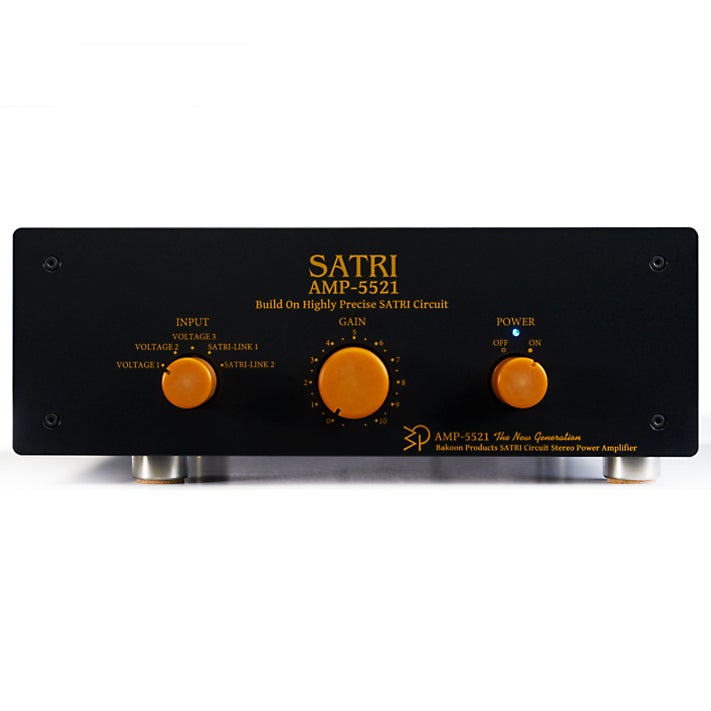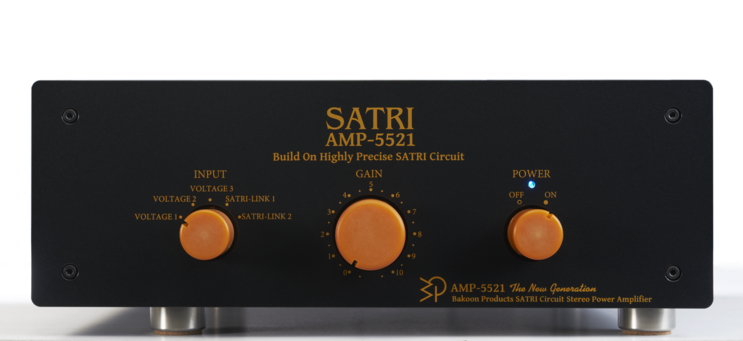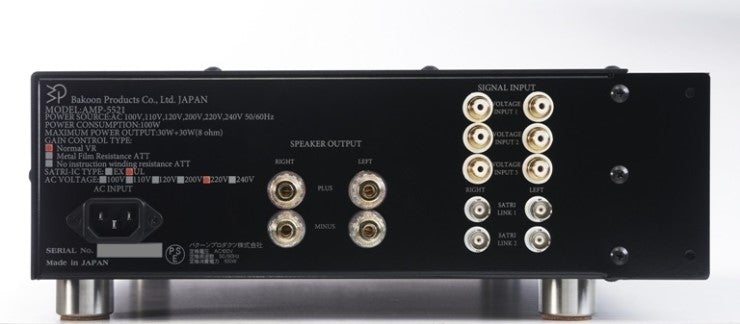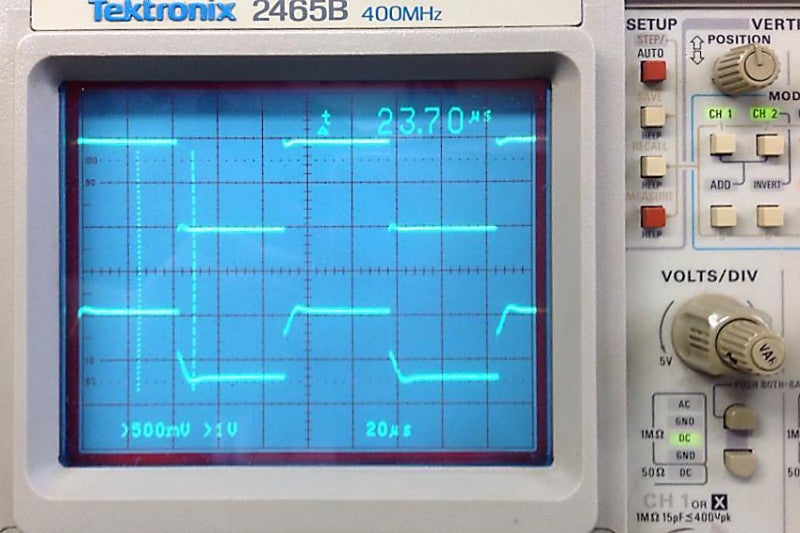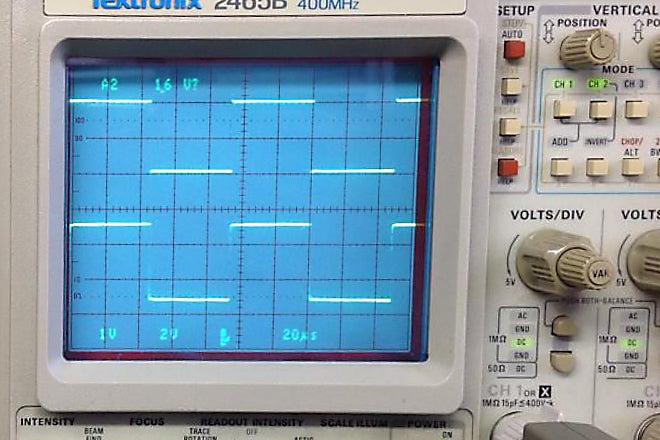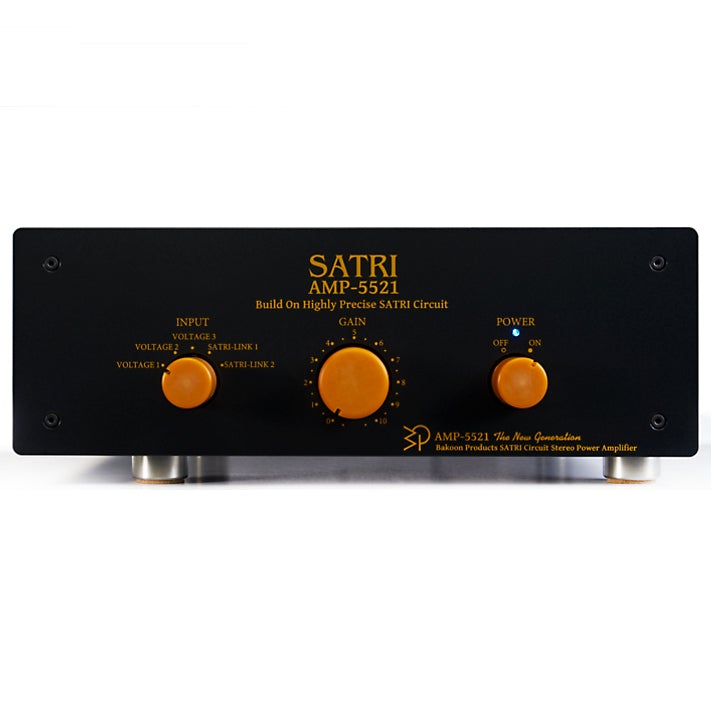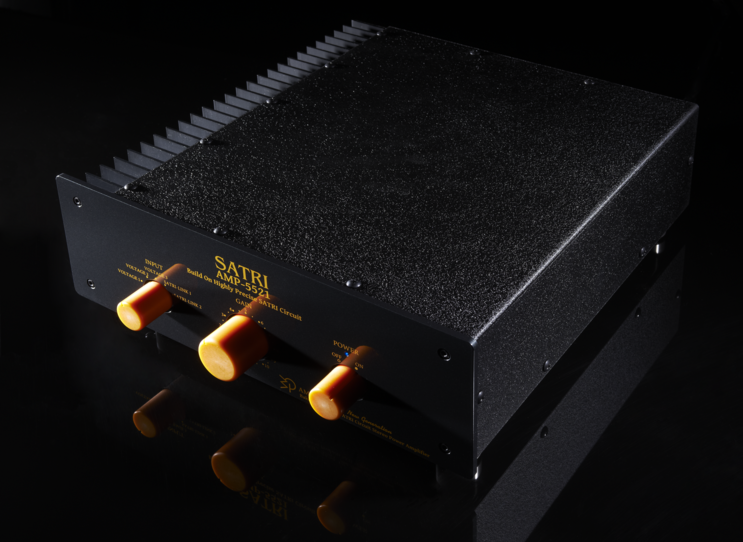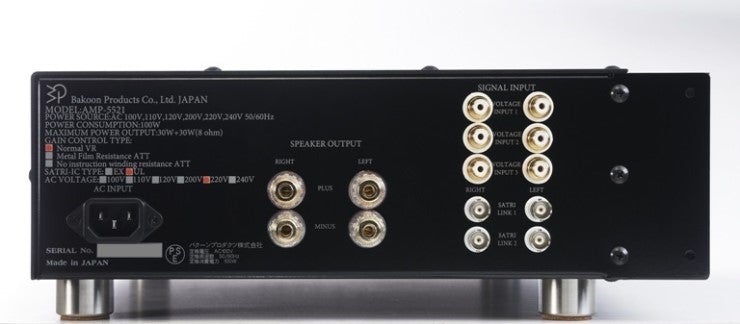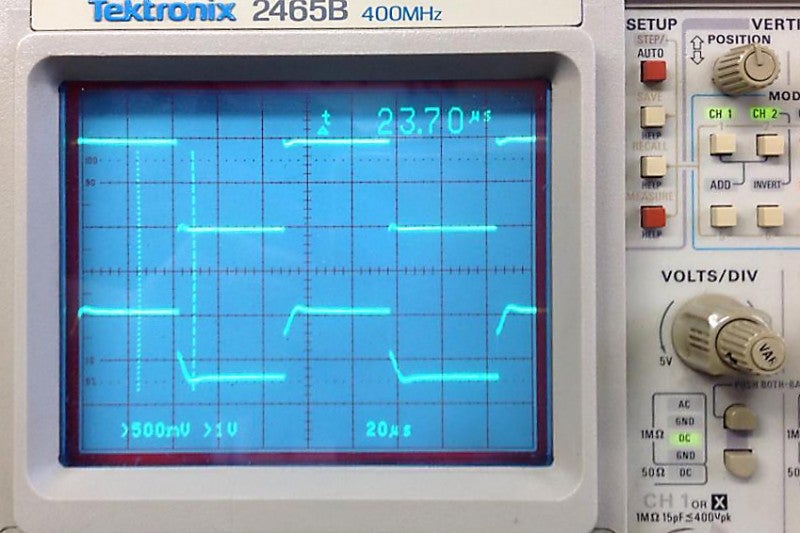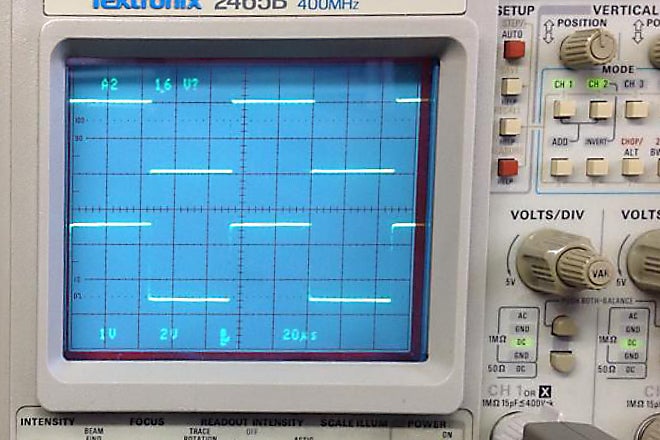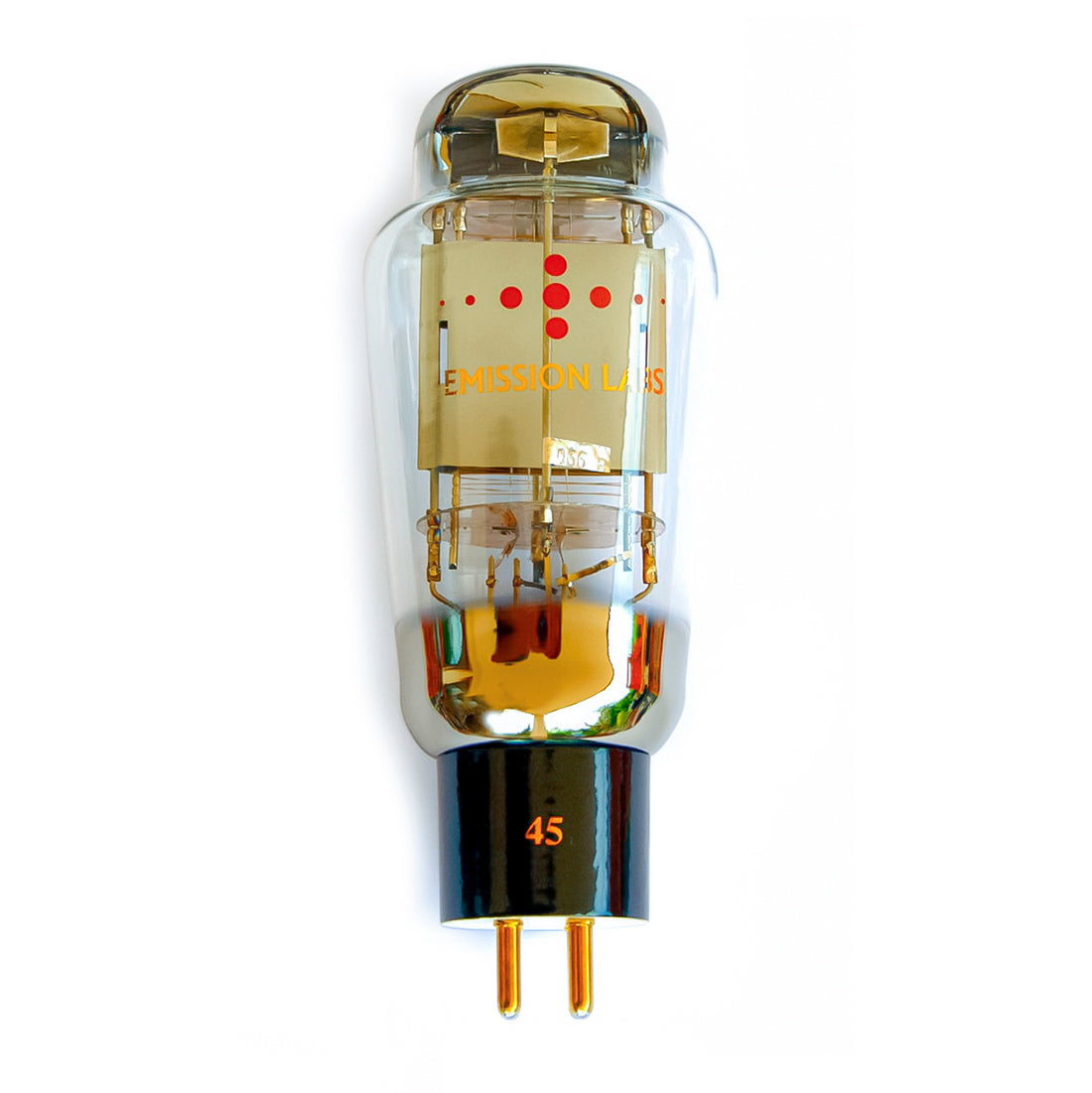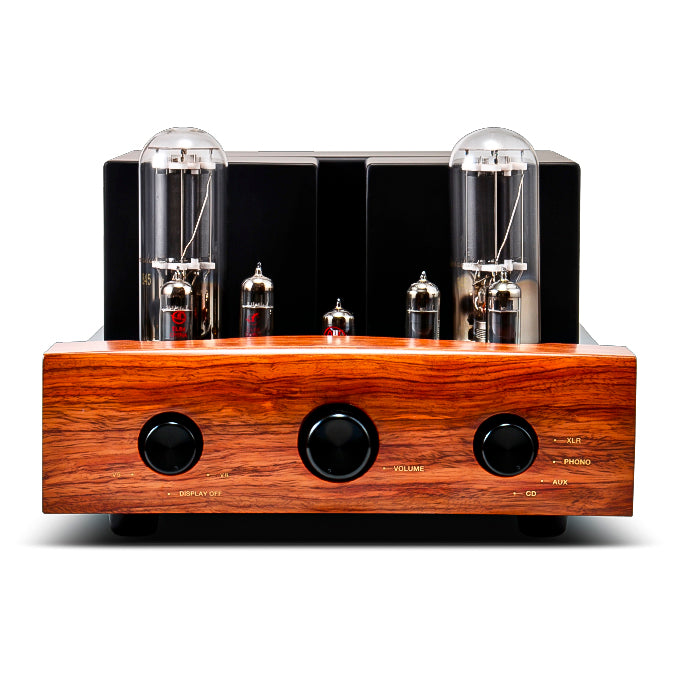Please note that some specifications may be changed without notice.
Surface-mounted components with no lead wires are used throughout the amplifier components. 35W+35W output in stereo, 100W output in monaural BTL specification.
Four newly designed HBFBC circuits

In addition to the SATRI-IC, the AMP-5521 MK4 uses bipolar transistors instead of J-FETs, which are no longer available, a temperature-compensated constant-current bias circuit, a bias separation circuit for the output stage, a bias turbo circuit that reduces the bias setting time from 4 minutes to 30 seconds, and a new HBFBC circuit. Most of the components are now surface-mounted components.
The number of parts exceeded 350.
The output power is 35W+35W in stereo, and 100W in monaural BTL specification.
The most significant feature is the overall use of surface-mounted components that have no lead wires in the parts that make up the amplifier. This has made it possible to create an amplifier that is 50 times more precise than those using conventional lead-wire components. When lead wires are present, the sound is colored by their materials and properties. By eliminating the lead wires, the coloring was also eliminated, and in using surface mount components, the design method of the printed circuit board on which the components are mounted was reviewed. We have reduced the wiring length of the printed pattern, which is colored in the same way as lead wires, to 1/4 or less, and we have developed many new circuits that can be made more precise by using surface-mount components. The AMP-5521 has succeeded in reducing the time required for the bias current to stabilize from 4 minutes to less than 10 seconds, and when used with SATRI speakers, the playback is so realistic that the player seems to be right in front of you.
The maximum output power is reduced to 35W in order to reduce the heat generated by the SATRI-IC.
This amplifier is characterized by its extremely high circuit precision. Drift is stable in the 10 microV range.
The constant current source used for the bias circuit was changed from a CRD to a temperature-compensated constant current circuit, which works well.
Furthermore, since the components on the PCB are now surface-mount components, inductance and stray capacitance have been reduced, and the number of elements that affect the music signal has been drastically reduced. Thanks to this, there are no incidental sounds on the music. The sound is frighteningly realistic.
The BTL mode is fantastic.
The maximum output in normal mode was 35W, but in BTL mode it is 97W. Also, the distortion rate is one order of magnitude lower than in normal mode. The powerful sound of BTL mode is very attractive.
| Maximum Output | 4Ω load/10% distortion: 54W 8Ω load/1% distortion: 35W: BTL mode: 97W 4Ω load/10% distortionr: 44.3W 8Ω load/1% distortion: 28W |
|---|---|
| Frequency Response | 8Ω/1W; 20Hz:0dB, 20kHz:0dB, 50kHz:-0.6dB, 100kHz:-6.29dB 8Ω/10W; 20Hz:0dB, 20kHz:0dB, 50kHz:-0.7dB, 100kHz:-6.4dB |
| S/N Ratio | VR max: -100dB, VR min: -127dB |
| Dimensions | 350(W)x130(H)x400(D)mm |
| Weight | 7.5Kg |
*Stereo and BTL switching is set at the time of manufacture of the amplifier board and cannot be changed by the customer.
SATRI amplifiers are characterized by excellent transient characteristics and low time distortion because no negative feedback is applied.
This picture shows the 10 kHz square wave characteristic of AMP-5521.
The top is the input and the bottom is the output, with a load resistance of 8Ω.
As you can see, there is no waveform distortion at all.
No amplifier reproduces the recording information as morosely as this one.
Listening to recordings in which even spatial expression is taken care of, a sense of depth is clearly apparent. a characteristic of SATRI amplifiers is that noise is reduced when VR is lowered, so the S/N is improved by 27db when VR is lowered. Another feature is that there is little bandwidth variation with output. Pinpoint localization is pleasant. This may be a feature of the buffer circuit composed of 12 bipolar transistors and a temperature-compensated constant-current circuit instead of the two J-FETs that are no longer available. The accuracy of this circuit is far superior to the current one.
The AMP-5521 is also expandable, allowing the user to further expand the range of speaker use. An unadjusted continuous variable resistor volume is standard, and up-graded versions, such as a 23-stage non-inductive wire-wound resistor attenuator version, are available as an option. Direct connection from a DAC or other source equipment is possible, but of course differences in sound quality exist when pair-matched with the company's preamplifier. The AMP-5521, a linear system using an R-core transformer, uses two outputs per channel to provide 35 watts of output power. With the gain set at 9 o'clock, the volume of a typical solid-state amplifier is about 100-150W. The mono amp version is 97 W output. The output ratio also expands rapidly, not felt with normal linear amplification, and the output does not consume much volume. Another essential feature of the Bakun amplifier's visuals is its inherent appeal when configured as a whole system. The sound is much more agile than in previous versions of the product, and the drive is incomparable. The phase response is also very good, and the overall freshness and stimulation makes strokes easier, more natural, and "realistic. The sound quality is stable and pure, even with fast beats and large ensembles.
*Audio Monthly (http://www.audioht.co.kr)
The moment I heard the 5521, I thought to myself, "This is just like a Satori circuit, just like a Bakun amplifier. The reproduced sound was as clear, transparent, and beautiful as a fountain. There was no distortion or coloration, linear amplification, and no time delay. The key factors behind this pure reproduction were the SATRI-IC, which limited the output so that the Satori circuit could maintain optimum conditions, and the "non-negative feedback," which is the unwritten rule of Bakun amplification.
The 5521 is characterized by its "pinpoint localization. When the sound from both speakers instantly overflows and gathers in the center of the room, the delicate image of the sound is pinpointed and connected to the center of the room. From the very beginning, the sound seemed to dance on the 5521 top panel placed in the center of both speakers. After all, we are talking about a good sense of localization, but what really happened inside the 5521? The supply of fixed bias current is such an important factor that the Bacoon amplifier is capable of ultra-precise reproduction. In a typical bias circuit, the bias current is controlled so that the temperature of the output transistor is kept constant, so that as the supply voltage rises, the bias current is decreased and as the output transistor temperature drops, the bias current is increased. In this way, the bias current is always variable, and the overall operation can only become unstable as well. In comparison, the Bacoon amplifier provides a fixed bias current at a level of 1/100,000th of a percent of variation. This ultimately enables accurate amplification and reproduction, which appears to have played a decisive role in pinpoint imaging.
While monitoring the 5521, I was struck once again by how strangely similar the Bakoon amplifier is to a tube amplifier. If the 7511A's output of 15 watts is like driving two KT150s in push-pull mode, the 5521 is like driving a 300B and two direct-heat triode tubes in parallel singles. The one that pushes the speaker through is rather the 7511, while the 5521 is the one that caresses the speaker with room to spare. The most surprising thing about the 5521 is that its 35W output power is so good that it seems meaningless. The most surprising thing about the 5521 is its bandwidth balance and signal-to-noise ratio (SNR), which shines even more brightly when the drive power and volume are turned down.
Bill Evans album - I know the audience coughing on "My Foolish Heart" is female. Obviously, the sound particles became larger and harder. The cymbal touch of the drums was more powerful and the image more expansive. The sense of rhythm was more surviving. The sense of space in the jazz club is more easily perceived. The current system seems to be very quiet, judging by the fact that there is no significant change in SNR when the volume is turned up. Even the whispers of the audience are all captured. During "Waltz For Debby (Take 2)," the sound from both side speakers seemed to holographically converge in the center. The height difference between the bass and piano is not mischievous. The sound of friction touching the bass strings and playing technique can be heard vividly. The sense of forward and backward movement of each instrumental sound is amazing. Depth" would be an apt description. Bill Evans' piano is clear and sharp.
Brian Bromberg's "Come Together" (Wood album) - The texture and capture of the 300 year old wood bass is phenomenal. That is a powerful bass overflowing. It's a full-scale bass. It's like you have to count your fingers to play a Beatles melody on four bass strings. You can feel this momentum and energy as it is. The tapping, clipping, fingering... It overflows like gospel handclaps in a church. Every single expression and texture of sound is captured, and that too in the center of the stage, in perfect pinpoint, in real size...
Vladimir Ashkenazy and Ada Mynick Shoshakov Beach Viola Sonata (DG) - overwhelming in energy and space. We began to be showered with sound in earnest. The front wall finally began to disappear and so did the speakers. The instruments and tones became even more three-dimensional. As a whole, the viola was above and the piano below. Yet they seem to play separately, yet they are elaborately woven into each other. The texture of the weave is exquisite; the high part of the viola at 7:30 is quite a sense of energy. The sense of color shines through. Transfer, power, high profile, majesty, white, savage, raw... . Words pour out of many of the images. From this point on, the viola player takes a breath. This means that the player needs so much energy. At 12:28, even the sound of Ashkenazy taking his foot off the pedal is recorded.
The fact that the bias current was completely dropped from the signal current, and the use of surface mount components to eliminate the various resistances caused by the leads, also resulted in a pure and precise reproduction of the music signal. Correct. The Bakun amplifier is a world of infinitely transparent sound reproduction without any distortion or coloration, and without a trace of time delay. It is also a world of painfully fast, cool, ultra-fast, ultra-precise amplification.
*Audio Monthly (http://www.audioht.co.kr)
